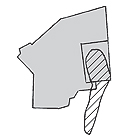Second Temple Period >>The Time of Nehemiah, Fifth Century BCE
|

|
The Second Temple period is divided into three secondary periods: the time of Nehemiah, the Hasmonean period and the period of the Herodian dynasty (according to the division proposed by D. Bahat 1989).
Nehemiah arrived in Jerusalem in 445 BCE. During his time the city wall fulfilled another important role besides providing physical security for its residents and it was "…a means of safeguarding its character as a Jewish city - closed to pagans and strictly adhering to the religious commandments and observing the Sabbath and the holidays" (Y. Tsafrir 1977, p. 31). The area of the city and the perimeter of the walls during the time of Nehemiah are in dispute. There are those who maintain that this was a small city that was only situated within the ancient core of the City of David and the Temple Mount. And there are the maximalists who include the western area of the city within it. The prevailing opinion today is that the area of the city was limited.
Finds:
No remains from this period were discovered inside the Jewish Quarter. Nevertheless, a plethora of finds was revealed in the City of David where large building projects were constructed, among them: the birah (or citadel, which later is the Antonia fortress) in the northwestern corner of the Temple Mount and water systems that conveyed water to the Temple.
Historical Sources:
The Book of Nehemiah, the writings of Timocharis and the Letter of Aristeas.
Nehemiah goes out at night to inspect the condition of the city walls:
"…So I came to Jerusalem and was there three days. Then I arose in the night, I and a few men with me; and I told no one what my God had put into my heart to do for Jerusalem. There was no beast with me but the beast on which I rode. I went out by the night by the Valley Gate to the Jackal's Well and to the Dung Gate, and I inspected the walls of Jerusalem which were broken down and its gates which had been destroyed by fire. Then I went on to the Fountain Gate and to the King's Pool; but there was no place for the beast that was under me to pass. Then I went up in the night by the valley and inspected the wall; and I turned back and entered by the Valley Gate, and so returned. And the officials did not know where I had gone or what I was doing; and I had not yet told the Jews, the priests, the nobles, the officials, and the rest that were to do the work. Then I said to them, "You see the trouble we are in, how Jerusalem lies in ruins with its gates burned. Come, let us build the wall of Jerusalem, that we may no longer suffer disgrace…" (Nehemiah 2:11-17)
The measures taken to renovate the walls:
"Now when the wall had been built and I had set up the doors, and the gatekeepers, the singers and the Levites had been appointed…And I said to them, "Let not the gates of Jerusalem be opened until the sun is hot; and while they are still standing guard let them shut and bar the doors. Appoint guards from among the inhabitants of Jerusalem, each to his station and each opposite his own house." The city was wide and large, but the people within it were few and no houses had been built…" (Nehemiah 7:1-4)
Remarks:
The 'minimalist' view is based on the absence of remains in the Jewish Quarter. The 'maximalist' view believes that Nehemiah was engaged in rehabilitating the city walls of the First Temple period, which followed the long route that includes the Upper City, and the paucity of finds is insufficient reason to negate the larger city.
|
|

| The city at time of Nehemiah |
|















